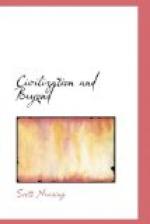We have been using the word “murder” to describe the wholesale slaughter of Europeans by Europeans that took place from 1914 to 1918 and from 1936 to 1945. The word “murder” is inaccurate. The Europeans who carried on the wholesale destruction and mass murder during the two most general wars of modern times were committing murder in one sense. In quite another sense they were engaged in collective suicide. Europeans were blotting out the life and well-being of fellow Europeans. When the process came to a temporary halt in 1945 every European participant in the struggle was weaker in human potential and poorer in economic means than they were when the war began.
Arnold Toynbee describes the entire episode as the “down grading” of Europe. He might have added two words and reported “the down grading of Europe by Europeans”, as a glaring example of large scale, long continued, deliberate self-destruction.
Fundamental social changes were bound to follow the revolutionary technical transformations that took place during the world-wide revolution of 1750-1970. Changes may be made in various ways. Some are slow and relatively painless, particularly when they extend over generations; other changes are so rapid that they are agonizingly painful. Involuntary changes, made under outside pressure are almost always painful. World-wide revolution, under the best of conditions, promises to be painful. When it comes from alien sources, and is under forced pressure, the costs are almost sure to be excessively high.
This brings us face to face with one of the most important problems facing mankind at the present moment. Given the worldwide revolution of the past two centuries, what changes—political, economic, sociological and ideological—must be made to prepare the way for the new society and shift the family from the old homestead to the new apartment with a minimum of pain and a maximum of satisfaction?
CHAPTER TWELVE
TALKING PEACE AND WAGING WAR
Blatant contradictions disorganized human life after war’s end in 1945. In the crucial area of war and peace three groups were bidding for attention: dedicated peace partisans (peacenicks); nationalist enthusiasts waging wars of liberation; and massive semi-official and official nationalistic groups busily preparing for the next big war.
Occasionally these groups joined hands on “hot” issues. Generally they were far apart. Often they were in active opposition.
Dedicated peace advocates were an important factor in this post-war period. They had been vocal and influential in July, 1914 immediately before the outbreak of the first general war. They had continued to play an active role between the first and second general wars. In the autumn of 1972 the World Peace Council called together a peace assembly in Moscow representing significant elements from 143 countries. The largest single element in the World Peace Council was the Socialist bloc, headed by the Soviet Union.




